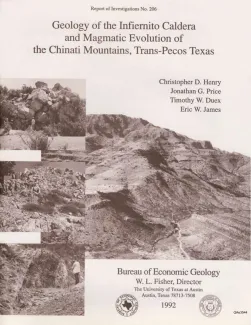
Publication Details
Geolocation:
Get the Publication
$21.00
Abstract/Description:
The 37-Ma-old Infiernito caldera of the northern Chinati Mountains is a major eruptive center of the mid-Tertiary volcanic field of Trans-Pecos Texas. Volcanism in the Chinati Mountains began with eruption of a sequence of rhyolitic to trachytic lavas, the precollapse lavas. These lavas progress stratigraphically upward from aphyric or sparsely porphyritic rhyolite to abundantly porphyritic trachyte; they appear to represent tapping of a compositionally zoned magma chamber. Eruption of the peralkaline to metaluminous Infiernito Tuff induced contemporaneous collapse of the Infiernito caldera, which is at least 12 km (7.5 mi) in diameter. The Infiernito Tuff ponded within the caldera to a possible maximum thickness of 1,800 m (5,900 ft). Caldera collapse breccias, derived from the caldera wall during eruption, are interbedded with the tuff. The tuff spread at least 20 km (12 mi) to the northwest from the caldera and unknown distances in other directions, where the tuff is largely covered by younger deposits. In contrast to its great intracaldera thickness, the tuff outside the caldera is no more than 20 m (66 ft) thick. After ash-flow eruption, the Infiernito caldera was filled by a quartz trachyte lava flow and interbedded sandstones and debris-flow deposits that represent continued failure of the caldera wall. The entire caldera-fill sequence, as well as precollapse lavas and underlying Cretaceous and Permian sedimentary rocks, was uplifted and tilted outward by the Ojo Bonito quartz monzonite intrusion. This intrusion represents resurgence of the magma chamber and the last major igneous activity of the caldera. Extensive hydrothermal alteration associated with the intrusion produced numerous mineral prospects, including epithermal veins, skarns, and porphyry-type mineralization. Volcanism continued episodically in the Chinati Mountains area for another 5 m.y. About 34 Ma ago, several rhyolite intrusions were emplaced west of the Infiernito caldera, and a moderate-volume ash-flow tuff, here named the Shely Tuff, erupted from sources now buried beneath the Chinati Mountains caldera. Volcanism in the Chinati Mountains culminated with eruption of the 32-Ma-old Mitchell Mesa Rhyolite, the largest ash-flow tuff in Trans-Pecos Texas. Eruption of the Mesa induced collapse of the Chinati Mountains caldera, the largest caldera in the region. The caldera was subsequently filled by a complex sequence of mafic to silicic lavas and ash-flow tuff and was then intruded by the composite West Chinati stock.